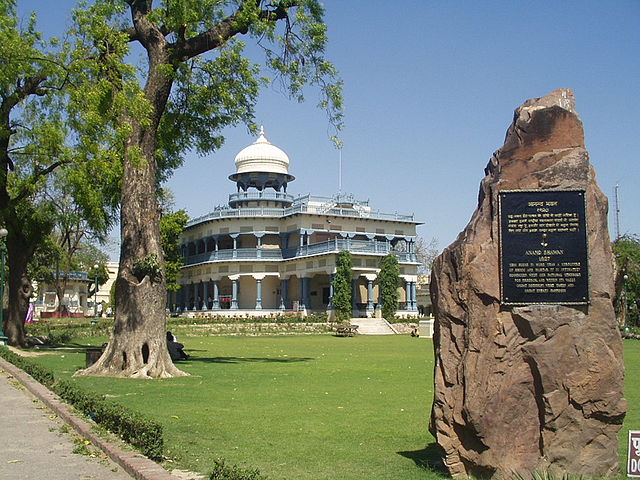Anand Bhavan: Gandhi Family's Residence in Prayagraj

Anand Bhavan, located in Prayagraj (formerly Allahabad), holds a prominent place in India's history as the ancestral home of the Nehru-Gandhi family. Originally built as a sprawling mansion in the early 20th century, it served as a pivotal hub for political discussions, strategy sessions, and social reform initiatives during India's struggle for independence. Here, we delve into the rich history, cultural significance, and enduring legacy of Anand Bhavan, often referred to as the "Nehru-Gandhi Family Museum."
Historical Background
Anand Bhavan was constructed in 1930 by Motilal Nehru, a prominent leader of the Indian National Congress and the patriarch of the Nehru-Gandhi family. The name "Anand Bhavan" translates to "Abode of Happiness," reflecting the family's desire to create a sanctuary dedicated to fostering joy, unity, and the pursuit of national freedom. The mansion became a symbol of the Nehru-Gandhi family's commitment to India's independence movement and their dedication to social justice and equality.
Gandhi Family's Residence
Anand Bhavan served as the primary residence of the Nehru-Gandhi family for several decades. It was home to Motilal Nehru, his wife Swaroop Rani Nehru, and their children, including Jawaharlal Nehru, who later became India's first Prime Minister. The house witnessed numerous historical events, political debates, and gatherings of intellectuals and freedom fighters who shaped the course of India's struggle against British colonial rule.
Role in India's Freedom Movement
Anand Bhavan played a crucial role in the Indian independence movement. It served as a strategic center for planning and organizing political campaigns, protests, and civil disobedience movements led by Mahatma Gandhi, Jawaharlal Nehru, and other prominent leaders. The house echoed with discussions on non-violence, civil rights, and economic equality, laying the foundation for India's future as a sovereign nation.
Architectural and Cultural Heritage
Architecturally, Anand Bhavan reflects a blend of colonial and Indian styles, characterized by its spacious rooms, verandas, and a distinctively designed library. The mansion's interiors feature period furniture, personal belongings of the Nehru-Gandhi family, and artifacts that chronicle their journey through India's tumultuous struggle for independence. The sprawling gardens surrounding Anand Bhavan add to its serene ambiance and historical charm.
Gandhi Museum and Visitor Experience
Today, Anand Bhavan operates as the Jawaharlal Nehru Memorial Museum and Library, showcasing a vast collection of memorabilia, photographs, and documents related to the Nehru-Gandhi family and India's freedom movement. Visitors can explore the museum's galleries, which depict the life and times of Jawaharlal Nehru, Indira Gandhi, and other members of the family through exhibits, audio-visual presentations, and interactive displays.
Educational and Cultural Significance
Anand Bhavan serves as an educational institution, offering insights into India's political evolution, social reforms, and cultural heritage. Educational programs, lectures, and seminars held at the museum promote civic awareness, historical literacy, and the principles of democracy advocated by leaders such as Mahatma Gandhi and Jawaharlal Nehru. The museum's archives are a valuable resource for researchers, scholars, and students interested in Indian history and political science.
Preservation Efforts and Legacy
Efforts are underway to preserve Anand Bhavan's architectural integrity and historical significance. Conservation projects ensure that the mansion maintains its structural stability and cultural relevance for future generations. The museum's curatorial team continually updates exhibits and engages in outreach activities to enhance public awareness of India's freedom struggle and the enduring legacy of the Nehru-Gandhi family.
Impact on Prayagraj's Cultural Landscape
Anand Bhavan stands as a cultural landmark in Prayagraj, attracting tourists, historians, and dignitaries from around the world. Its role in shaping India's modern history and its association with eminent personalities make it a symbol of resilience, leadership, and visionary governance. The museum's contribution to promoting tourism and cultural exchange underscores its significance in Prayagraj's dynamic cultural and economic landscape.
Conclusion
In conclusion, Anand Bhavan is more than a historic mansion; it embodies the spirit of India's quest for freedom and social justice. As the former residence of the Nehru-Gandhi family, it symbolizes their dedication to nation-building and their enduring legacy in shaping India's democratic ethos. Anand Bhavan continues to inspire generations with its stories of courage, sacrifice, and the relentless pursuit of a just society. Visiting Anand Bhavan offers a profound glimpse into India's past and serves as a reminder of the ideals that continue to shape its future.
